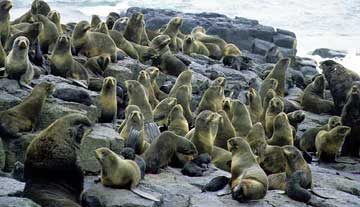 July 14, 2004
The North Pacific Research Board awarded scientists from NOAA's National Marine Mammal Laboratory (part of the Alaska Fisheries Science Center) and the University of Alaska, Fairbanks $244,000 for the study. NOAA scientists Rolf Ream and Brian Fadely, along with Alan Springer of the University of Alaska in Fairbanks and Sara Iversion of Dalhousie University, will begin the study this fall. Northern fur seal numbers have been declining on the Pribilof Islands since 1998 due to unknown causes. Northern fur seals are listed as a depleted species under the Marine Mammal Protection Act. Before the 1970's Bogoslof Island showed little to no habitation by northern fur seals. But that changed in the following decade. By 1980 fur seals were more common on Bogoslof Island and scientists recorded a few fur seal pups born there. The last Bogoslof Island pup production estimate, taken in 1997, was 5,096. From 1980 to 1997 the fur seal population on Bogoslof Island grew by 59 percent a year. "The Bogoslof rookery is important to the status and sustainability of fur seals in Alaska," said Ream. "With the grant money we hope to determine why the population on Bogoslof has fared so well. While on Bogoslof conducting this research, we will also have the opportunity to obtain a new population estimate to see if the numbers of fur seals have continued to grow at such an extraordinary rate. All of us at the National Marine Mammal Laboratory are anxious to get going on the project." Scientists will begin the next Pribilof Island fur seal census in August of 2004. Northern fur seals were hunted nearly to extinction by Russian and American seal hunters during the early 1800's. A ban on fur seal hunting at sea was finally enacted in 1911 between Canada, Russia, Japan, and the United States when it was observed that fur seal populations were in severe decline. Fur seal hunting on land was banned in the Pribilof Islands in 1984. Alaska Natives still harvest a small number of fur seals for subsistence purposes. Sporadic distribution of northern fur seals through out the world creates difficulty for an accurate population estimate by scientists. However, scientists agree that a majority of the fur seal population is found in Alaska. Because adult fur seals are often at sea, a census of seal pups is made at the Pribilof and Bogoslof rookeries to examine biological trends and to estimate the total number of fur seals in Alaska. National Marine Mammal Laboratory scientists start population estimation in the Pribilofs in mid to late July when most fur seals have arrived on the rookeries for mating and birth. Scientists return to the rookeries throughout the year to attach and collect satellite tags and to take condition measurements. Condition studies take into account the fatty acids, measurement, weight, body composition, and milk intake of female fur seals. Scientists became aware of volcanic activity on Bogoslof Island July 6 1992, when in a matter of minutes a large amount of rock was pushed up from the island creating a dome 100 meters high. Two years later scientists were still able to observe a low amount of volcanic activity in the form of several active fumaroles with temperatures as high as 165 degrees Fahrenheit. Ream, along with other scientists, observed the remains of several fur seals that they believed had died from the explosion and falling rock created by the volcanic activity. The deaths did not substantially reduce the fur seal population at the Bogoslof Island rookeries. The Pribilof Islands are two
islands roughly 200 miles north of Dutch Harbor. St. Paul is
located to the north with St. George to the south. Bogoslof is
a small island 2.0 km long and 0.75 km wide located 50 miles
northwest of Dutch Harbor.
Photo:
Source of News Release:
|
||
